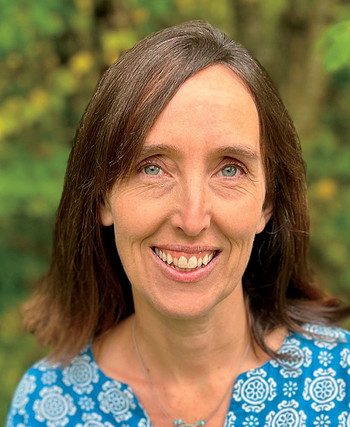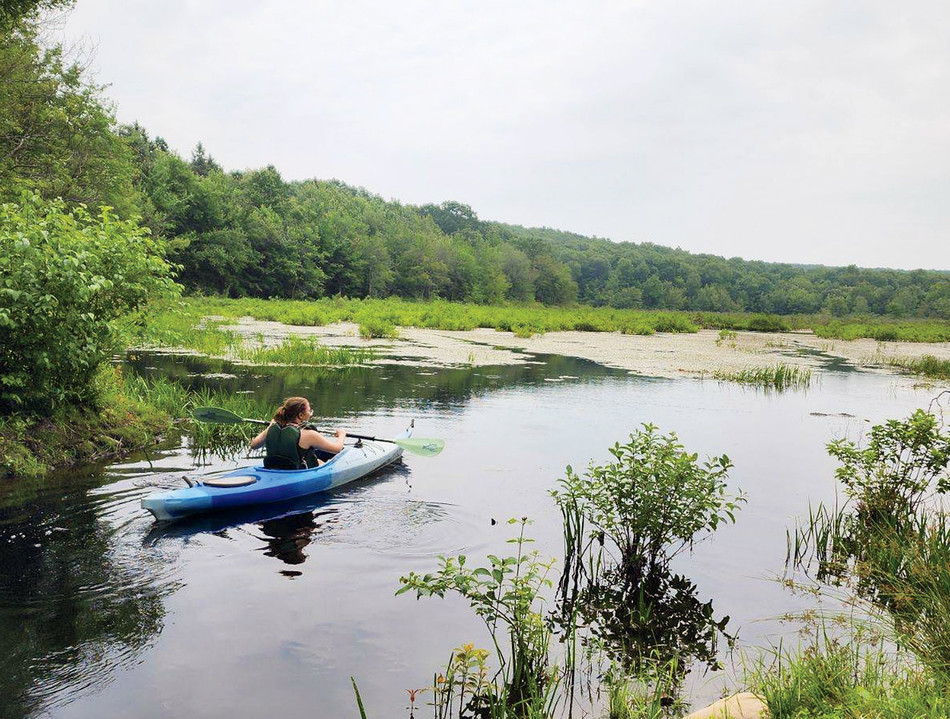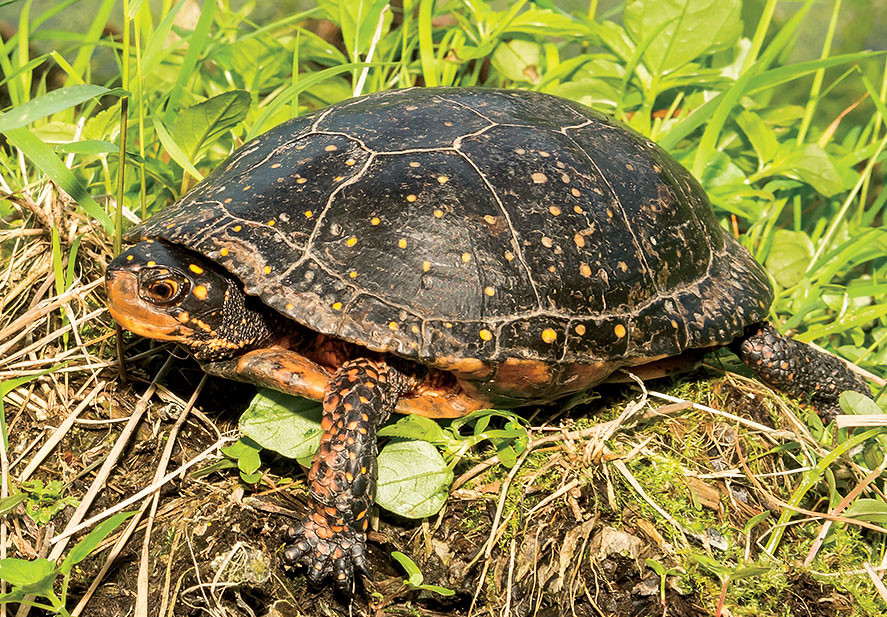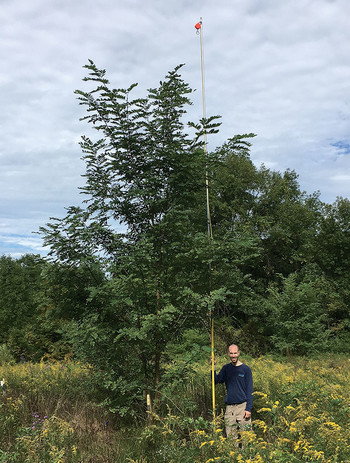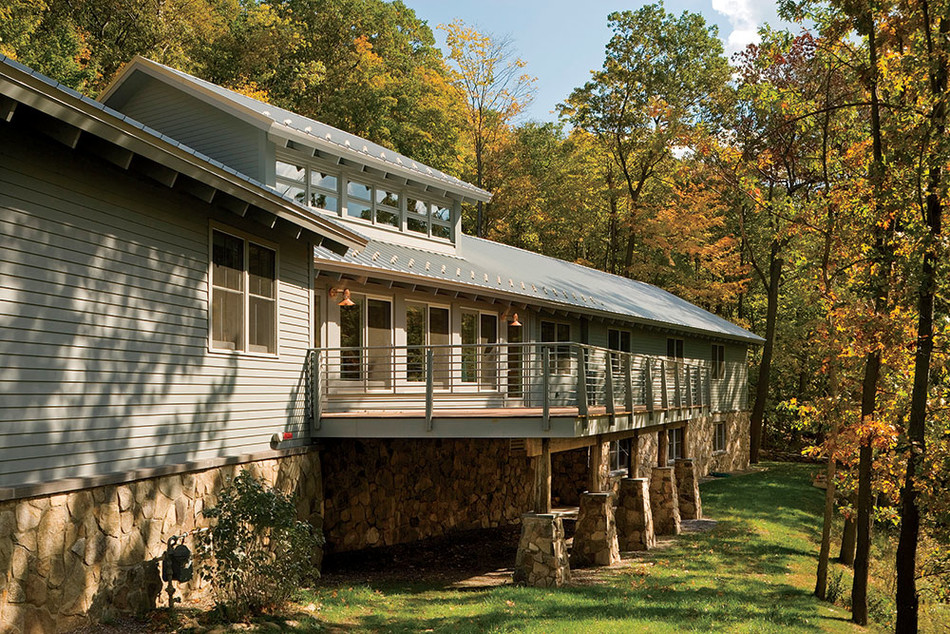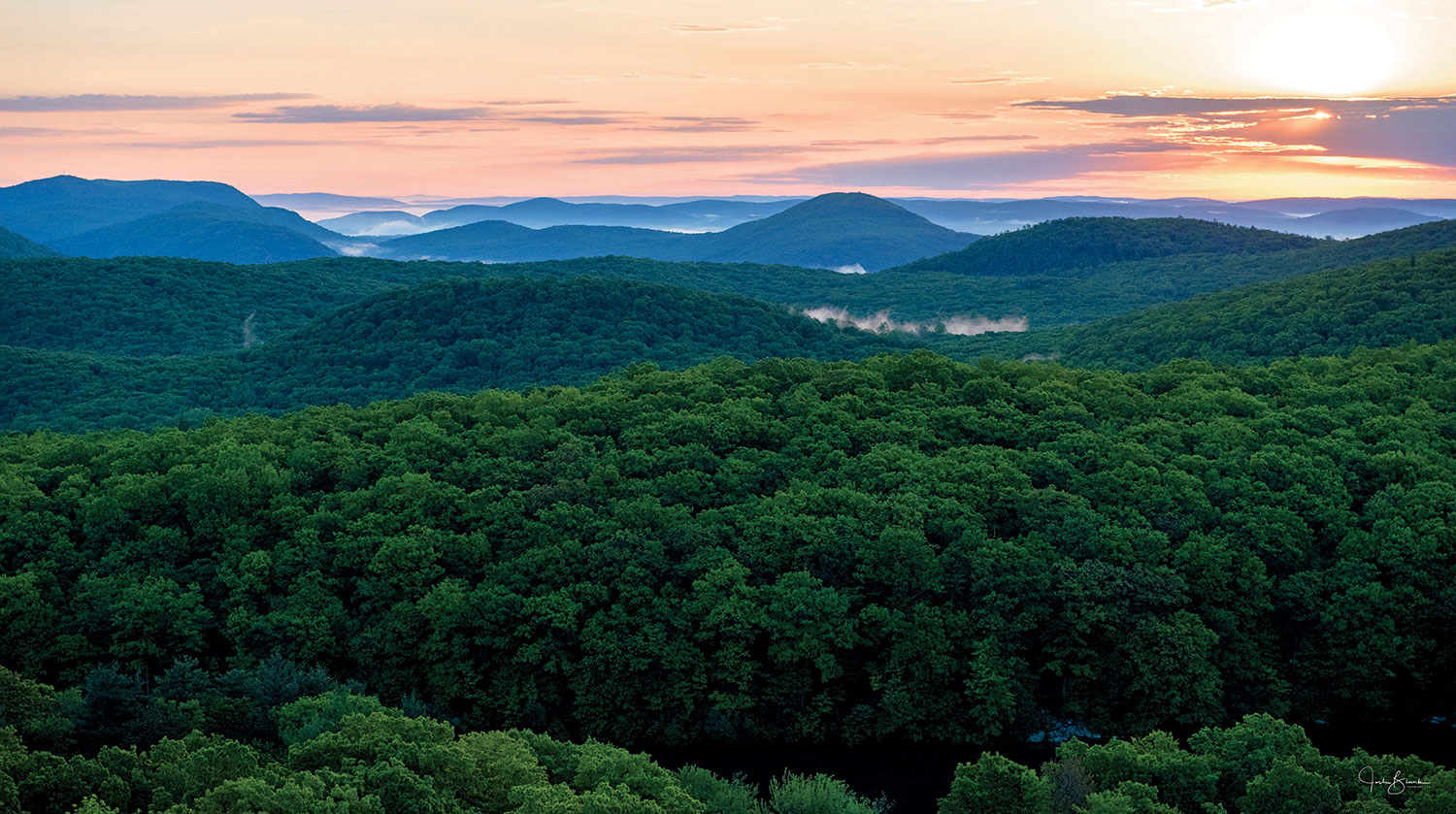
Somewhere in a hilly, deep-green wilderness fifty-five miles north of Morningside Heights, where the New York–New Jersey Highlands meet the Hudson River basin, a turtle climbs onto a rock to bask in the sun. All around, yellow light filters through the canopy of red oaks, down through maples and mountain laurel, pink and white wildflowers, huckleberry and blueberry bushes, to the decomposing leaf litter of the forest floor. Hidden amid the wooded slopes are white-tailed deer, red foxes, coyotes, bobcats, black bears, gray tree frogs, barred owls, and hairy woodpeckers. In the forest’s five lakes, there are mallards and Canada geese, water scorpions and dragonflies. The woods host 160 species of birds, 279 species of spiders, and sixty-five species of trees — mostly oak, but also maple, beech, black birch, black gum, sweetgum, and eastern hemlock.
This is Black Rock Forest, a 3,920-acre privately owned nature preserve in Cornwall, New York, named for the black magnetite that colors the forest’s mountainous gneiss bedrock. Here on the ridges and hills, in the valleys and ponds, you can also find another interesting species: Columbia Lions. These are the students, faculty, and alumni — most of them connected to Columbia’s Department of Ecology, Evolution, and Environmental Biology (E3B) — who for the last thirty years have made this forest one of the most productive biological field stations in the country.
“We do long-term science — that’s our business,” says Isabel Ashton ’98CC, who is the executive director of the nonprofit consortium Black Rock Forest (BRF), which manages the field station. Ashton, a plant ecologist with twenty years of experience in land management, education, and research, became director last year, presiding over an organization whose constituents have produced hundreds of scientific papers and dozens of master’s and PhD theses on such topics as the impacts of potential oak-tree loss; the effects of mercury on red-winged blackbirds; and seasonal and topographic variation in water supply. Researchers benefit not just from the laboratories, classrooms, and dormitories of the two-building BRF campus but also from nearly a century’s worth of detailed records of the forest’s flora and fauna, which allow them to trace changes in the forest over time. And through its grade-school and college programming and graduate-study grants, BRF has brought thousands of students into direct contact with the wonders of the woods. As Ashton says, “Everyone learns better outside.”
The importance of healthy forests can hardly be overstated: trees provide oxygen, cool the air, filter pollutants from groundwater, foster biodiversity, and, not least, absorb carbon dioxide through photosynthesis and store it in their tissues. In a world struggling with the buildup of CO2 in the atmosphere, intact forests are a key carbon “sink,” or repository: plants and soil absorb an estimated 30 percent of human-made carbon emissions.
But even well-kept forests like BRF face serious threats. “There are so many extremes with climate change: storms, droughts, and pathogens,” Ashton says. This past July, the forest was hit with an unprecedented rainstorm that caused flash flooding and destroyed an outbuilding on the property, but “the biggest challenge is to understand how these changes are affecting forests and to keep the forest healthy.” In 2020, Black Rock lost almost all its native ash trees to an invasive insect, the emerald ash borer. This year, a pathogen is menacing beech trees. “Life as a tree is getting more and more stressful,” says Ashton. “And like people, stressed trees are more susceptible to sickness.”
Ashton, who majored in biology at Columbia, notes that the forest was cleared for charcoal in the nineteenth century (with the arrival of European immigrants, nearly all old-growth forests in the eastern US were cut down, mainly for agriculture), and that most trees at Black Rock are between eighty and 120 years old. To the untrained eye, the landscape seems primeval, ageless. As Ashton says, “Trees grow fast around here.”
The green-gold forest has a light-blue pedigree. In 1929, Ernest Stillman 1913VPS, whose father, a railroad magnate and bank president, was one of the richest men in America, established Black Rock Forest on his vast property, endowed it as a research facility, and bequeathed it to Harvard upon his death in 1949. But the location, two hundred miles from Cambridge, proved inconvenient, and in 1989, Harvard sold the forest to William Golden ’79GSAS. An investment banker, philanthropist, and nature lover, Golden had counseled President Truman on science policy, helped create the National Science Foundation, and earned his master’s in biology from Columbia at age seventy.
It was Golden’s idea to form a dues-paying consortium of universities, schools, and science centers that would support the forest as a living laboratory while preserving its infinitely complex web of life. Today there are nineteen institutions in the consortium, including NYU, CUNY, the American Museum of Natural History, and many K–12 schools. Columbia is the most active user.
“If a grad student or prof comes in, they know they can tag trees that have been around for decades, which helps when you’re trying to understand the natural world,” Ashton says. “If you did the same study in Central Park, you couldn’t be sure that next year your tree or marker or equipment would still be there. We provide a safe, stable place for researchers to do their work.”
“It’s funny,” says Claire Levesque as she steps over a moss-coated log at the edge of a lush green marsh, where frogs and turtles swim among sun-splashed lily pads and grasses. “I came to New York City to study wildlife.”
Levesque, who grew up in Tulsa and whose parents are wildlife biologists, is a Columbia senior in E3B. She has been living at the forest for five weeks, part of a group of researchers led by Matt Palmer, who is Levesque’s thesis adviser, and Suzanne Macey, a biodiversity scientist from the American Museum of Natural History. The group, styling itself Team Turtle, is on a mission to track three kinds of turtles: the spotted turtle, the box turtle, and the painted turtle. Levesque is working on the spotted turtle, the smallest of the five turtle species found here (there are also wood turtles and snapping turtles). Spotted turtles have black shells speckled with yellow dots and grow to three and a half to five inches long. Once common in New York State, their numbers have dwindled due to habitat loss, pollution, road fatalities, and poaching. And because they, like all reptiles, are ectotherms — meaning their body temperature is dependent on the temperature outside — they might be more sensitive to climate change.
Levesque’s work will allow forest managers and biologists to track the distribution of spotted turtles. “And that makes it easier to advocate for conservation,” she says. “The more you know about the turtles, the better you know how to protect them.”
But tracking a turtle, especially an aquatic one, is not easy — or cheap. Commercial trackers can cost $1,500, making the study of multiple animals prohibitively expensive for many organizations. Team Turtle’s main goal is to develop affordable tracking tools that can be built from off-the-shelf components. The idea, says Palmer, is “to democratize the technology” so that any nature center with the proper permits can study the movements of animals. With help from IT experts including Jeremy Hise ’17GS, Team Turtle is testing small, lightweight attachments they call backpacks, which can be customized to hold devices that take such measurements as an animal’s location, speed, or body temperature.
“We know turtles move across the forest to get from pond to pond,” Palmer says. “But we don’t know much about how often or how far they move across the landscape. The backpacks will allow us to track individuals at a much greater spatial and temporal resolution and start to fill in the gaps: we’ll know a turtle’s route and how long it took. With a device that can register its location every ten minutes for a year, we can create an incredibly detailed model.”
On the communications side, Team Turtle is testing wireless technology that can communicate with Black Rock’s network of towers and access points throughout the forest. This would allow researchers to log in from anywhere in the world and pinpoint the location of animals practically in real time. But before Team Turtle can fasten backpacks on a rare species like the spotted or box turtle, it must first demonstrate to the state wildlife authorities that the technology works on the more common painted turtle — another milestone in their multiyear project.
In the meantime, Levesque pursues the spotted to perform a more traditional sort of tracking. So far, she has captured six spotted turtles from this marsh — a decent sample size, but she really wants seven. One problem with aquatic turtles is that they spend a lot of time underwater, where GPS and wireless can’t penetrate. And so Levesque is using VHF (very high frequency) radio telemetry, since the signals can be transmitted through water. Ultimately, Team Turtle wants to put both an old-school VHF transmitter and a high-tech backpack on the turtles to get the fullest picture of their movements.
“Black Rock is a hot spot for wildlife. We get a wide array of friends.”
Levesque, in a pair of brown waders, approaches the marsh’s muddy brim. She points out the felled logs and gnawed, hourglass-shaped tree trunks that mark the presence of beavers. “Black Rock is a hot spot for wildlife,” she says. “I like to record what I see. We get a wide array of friends.” She plunges into the tea-colored water to check on the small cylindrical net just offshore. “You never know what you might find. I’ve gotten bullfrogs. Once I got a snapping turtle the size of a housecat.”
Levesque wants to know which habitats the spotted turtle is selecting around the forest. Her plan is to capture more spotted turtles from other ponds nearby and compare the data. “Spotted turtles are picky about their microhabitats,” she says, “so it’d be interesting to see if their preferences vary within the different populations in the forest, or if they are similar.”
Now she wades knee-deep to the net, which contains something. She looks. Might it be? — yes! — a spotted turtle.
Levesque carries the net to the dirt road twenty yards away, where Palmer and Macey are waiting with gear. Levesque pulls the turtle out, holding it by its shell and apologizing to the delicate creature as it works its legs and twists its neck. (All animal-handling protocols have been approved by the American Museum of Natural History and New York State.) The researchers measure the palm-sized specimen and determine its sex (male). Then Levesque swabs the shell with alcohol and makes tiny V-shaped notches at three different points on the edge of the carapace. “The outer part of the shell is kind of like a fingernail,” Palmer puts in. “It doesn’t have nerves.” The locations of the notches correspond to a mapped lettering system, so that any future researcher who recaptures this turtle can identify it and compare data.
With help from Palmer and Macey, Levesque glues a VHF transmitter with a tiny antenna to the shell. “One big concern about putting a tracking device on an animal is that it might change its behavior,” Palmer says. “You don’t want the device to make the animal more susceptible to injury or more likely to be killed by a predator or less attractive to a mate. So it’s an open question: what does it mean to put it on?” For Palmer, it’s a worthwhile tradeoff. “A slight inconvenience to the animal,” he says, “means we can learn an awful lot about its movements, its habitats, and its behavior, which in turn can allow us to better manage and conserve the populations.”
Levesque takes the outfitted turtle back to the water and releases it, and the creature quickly disappears into the placid pool of the quiet marsh in the wooded highlands.
“This forest is an incredible resource,” says Kevin Griffin, a professor in E3B and former president of the consortium. “It’s hard trying to teach ecology in an urban setting. If you want people to appreciate how the natural world works, there’s nothing better than to stand in the middle of it. BRF gives us the ability to take students to the woods and say, ‘This is what we’ve been thinking about, this is what we know, and this is what we don’t know. And just use your eyes, your senses. Take it in and ask yourself: How does that work?’”
Griffin, a plant physiologist who studies the role of trees in the carbon cycle, has lately been attaching dendrometers — devices that measure infinitesimal fluctuations in tree-trunk diameter — to dozens of trees in the forest, monitoring how they grow and change, minute to minute and day to day. He started teaching at Columbia in 1997, and for his first class he took students to the forest. His first graduate students did their dissertations here, and he and his students continue to study how the forest absorbs and stores carbon. Black Rock is considered a “mature” forest, meaning that it is in its period of peak carbon accumulation (according to Griffin, the forest is still storing carbon at about the same rate as it did in the 1930s). “We think one reason why North America absorbs a lot of carbon is because young forests remove more CO2 than older ones,” Griffin says.
While Griffin looks at CO2, Duncan Menge, an associate professor at E3B, is focused on the nitrogen cycle. Nitrogen accounts for 78 percent of the atmosphere and is vital to all life, including plants, which require it in other forms such as ammonia. But plants can’t transform nitrogen themselves — they need other organisms to do it for them. “There are unicellular organisms called nitrogen-fixing bacteria that can take nitrogen from the air and convert it into ammonia,” explains Menge. “Some of those bacteria live inside root structures called nodules, forming a symbiosis: they help nourish the plants, and in exchange, the plants give the bacteria a place to live and feed them sugar made from photosynthesis. Both get what they need, and for a long time, researchers thought this process, known as symbiotic nitrogen fixation, kept the nitrogen cycle at a balanced level.”
However, from 2015 to 2020, Menge studied the black locust tree, Robinia pseudoacacia, and found that 60 to 90 percent of the nitrogen in Robinia came from its symbiotic bacteria, even when there was more than enough usable nitrogen already in the soil. This was unexpected. “It’s strange: the trees have access to usable nitrogen, yet they still pay the bacteria a lot of energy to fix more nitrogen, which they don’t need.” This seeming inefficiency has consequences: when there’s too much fixed nitrogen, says Menge, other bacteria in the soil release it in the form of nitrous oxide, a greenhouse gas. “Why would these trees fix so much nitrogen? That’s the next question.”
Symbiotic relationships are the rule of the plant world. One of Menge’s PhD students, Aria Carreras Pereira, is working on another type of symbiosis, called a mycorrhizal association, which exists between most land plants and the fungi that colonize their roots. It’s a sweet deal: the plant provides the fungi with sugars through photosynthesis, while the fungi, with their branching, threadlike white filaments, help the plant absorb essential nutrients like nitrogen and phosphorous.
“Mycorrhizal fungi not only bring resources and water to the host plant, but they also connect with other mycorrhizal fungal tissue in the soil — and by extension connect different plants together,” Carreras Pereira says. “That’s called the common mycorrhizal network, and its existence is well established.” But whether it has additional functions is a point of debate: books like The Hidden Life of Trees, by the German forest scientist Peter Wohlleben, and Finding the Mother Tree, by the Canadian forest scientist Suzanne Simard, suggest that these networks transport not just nutrients but also electrical and chemical signals that enable a tree, for instance, to warn other trees of danger. “Some in the media have extrapolated to say that trees are communicating via these common mycorrhizal networks,” Carreras Pereira says. “But there are lots of unknowns.”
Mycorrhizal fungi come in two main types: one is dominant in tropical forests; the other prevails in boreal and Arctic ecosystems. But in temperate forests, like Black Rock, the two types coexist — sometimes within the same tree species, such as red oak. Carreras Pereira wants to know how a red oak seedling’s neighbors influence what type of fungi the seedling acquires. That matters, she says, because “the two mycorrhizae have different strategies for nutrient acquisition. That affects the forest biogeochemistry and could also impact the climate, due to differences in carbon storage.”
Her work also raises questions about tree agency: can the tree switch between the two types — implying something like an active role in the decision — or is it simply colonized? Or put another way: which organism is in control, the fungus or the tree?
To find out, Carreras Pereira has planted two batches of seedlings: one in the forest and the other in the Arthur Ross Greenhouse at Barnard, where she can manipulate the connections between trees to see how they transfer resources. “As tree species with one mycorrhizal type migrate northward into forest areas that have primarily the other mycorrhizal type, we want to know what will happen to the plants that are already there.”
“As the climate changes, so will the range of many animals. It’s critical that they have passageways.”
It’s yet another elegant example of the first tenet of ecology, attributed to the biologist Barry Commoner ’37CC, one of the architects of the modern ecological movement: Everything is connected to everything else.
No one knows this better than William Schuster ’78CC. As Black Rock’s first executive director (from 1992 to 2022), Schuster oversaw the construction of the BRF campus as well as the educational programs, and created paths for disabled people among the forest’s twenty-six miles of public hiking trails. In 2008, he produced a landmark survey of the forest’s trees and found that northern species like black spruce and paper birch, which were present in 1930, had disappeared and that more than half a dozen southern-range species had moved in.
But Schuster, who is now staff ecologist, says his greatest passion is for a very literal connectivity: wildlife corridors that would offer animals safe passage across a landscape tangled with highways and subdivisions. To that end, he hired wildlife biologist Scott LaPoint, a former Columbia postdoc who tracks bobcats and fishers (a carnivore in the weasel family) using radio collars. “Bobcats can’t cross major freeways,” says LaPoint. “So we’re asking animals: Where do you go? How do you get there? Where do you try to go and can’t?”
“These animals need large areas, or at least connected areas,” Schuster says. “Otherwise, they are not going to survive.” BRF has been acquiring parcels around the perimeter of the forest necessary for passage, and Schuster and LaPoint are working with the New York State Thruway Authority on a proposal for a wildlife overpass. (There are an estimated sixty to seventy thousand collisions between deer and vehicles each year in the state, which helps make the case.)
“As the climate changes, so will the range of many animals,” says Schuster. “It’s critical that they have passageways. My hope is that we will see a network of corridors as well as larger-scale models for connectivity across North America.”
Three days after capturing her seventh spotted turtle, Claire Levesque, equipped with a VHF receiver and antenna, returns to the marsh. She enters the still waters in a kayak and, following the receiver’s pings, homes in on the turtle’s location and marks it on a map. (It hasn’t gone far.) Through the trees, in a plot between the lyrically named elevations of Honey Hill and Hill of Pines, Aria Carreras Pereira’s seedlings extend their roots into the fungi-rich soil. At a nearby pond, Matt Palmer helps Kristen Kallok, a Barnard sophomore, retrieve the contents of a funnel-net trap: it’s a painted turtle, with brilliant red and yellow stripes and orange belly, recruited in the name of science and conservation to wear a Team Turtle backpack.
And up in her office in the BRF Science Center, Isabel Ashton conducts the daily business of long-term research — managing the consortium and meeting members’ needs. She still recalls the day in college when her professor H. James Simpson ’70GSAS, a biochemist who pioneered studies of water pollution, asked her if she’d like to work on a project involving tree rings and the effects of acid rain at a place called Black Rock Forest. Ashton was all in. She went up to the forest. “I thought it beautiful,” she says.
Today, she lives near the forest with her family. Black Rock is her second home, and it’s also the home of a great panoply of life. Decoding the mysteries of that life is an endless task, requiring day-to-day, year-to-year study among the oaks. As Ashton says, “If you really want to protect something, you’ve got to know what’s there.”
This article appears in the Fall 2023 print edition of Columbia Magazine with the title "A Lab in the Woods."
